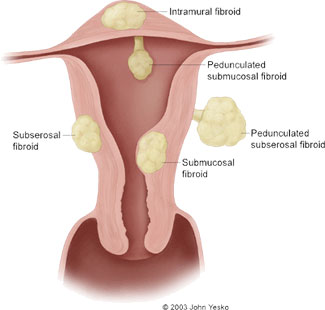Overview
What are Uterine Fibroids?
 Uterine fibroids are benign (noncancerous) growths in the uterus that many women experience during childbearing years. It is estimated that three out of four women have one or more uterine fibroids at some point in their lifetime. Also called myoma, leiomyoma, leiomyomata and fibromyoma, uterine fibroids almost never develop into cancer and aren't linked to an increased risk of uterine cancer.
Uterine fibroids are benign (noncancerous) growths in the uterus that many women experience during childbearing years. It is estimated that three out of four women have one or more uterine fibroids at some point in their lifetime. Also called myoma, leiomyoma, leiomyomata and fibromyoma, uterine fibroids almost never develop into cancer and aren't linked to an increased risk of uterine cancer.
Types of fibroids
Fibroids vary in size from tiny masses, undetectable to the eye, to large growths that can alter the size of your uterus. The four primary types of fibroids are:
- Intramural: The most common type of fibroid, these develop inside your uterine wall and expand, which makes the uterus feel larger than normal. Symptoms can include heavy menstrual flow, pelvic pain, back pain, frequent urination and pressure.
- Submucosal: These form just under the inner lining of your uterus. The least common type of fibroid, they often cause symptoms, such as very heavy, prolonged menstrual periods.
- Subserosal: These develop in the outside of your uterus and continue to grow outward. They typically do not affect your menstrual flow, but can cause pain due to their size and pressure on other organs.
- Pedunculated: These occur when the fibroid develops on a stalk, and can grow into or out of your uterus.
Care and treatment
Many women are unaware they have uterine fibroids, because they have no symptoms. Often, your physician discovers one or more during a routine gynecological exam.
If you are diagnosed with uterine fibroids and have no symptoms, there is no need for treatment. Your physician will simply monitor their growth at your annual exams.
If symptoms of uterine fibroids are impacting your life, Northwestern Medicine offers a range of treatment options, from medication to minimally invasive treatments and surgery. Our skilled and caring women’s health specialists* can help you understand your options and recommend the best course of treatment for you. Treatment options include:
- Uterine fibroid embolization: A nonsurgical procedure that is used to shrink fibroids by stopping the blood supply to the fibroid. This procedure allows your uterus to remain intact.
- Medication: Anti-inflammatory painkillers are often effective for women who experience occasional pelvic pain or discomfort.
- Hormones: Gonadotropin-releasing hormone agonists (GnRH agonists) lower levels of estrogen and triggers a "medical menopause." Sometimes GnRH agonists are used to shrink the fibroid, making surgical treatment easier. Anti-hormonal agents oppose estrogen (such as progestin and Danazol) and appear effective in treating fibroids. Anti-progestins, which block the action of progesterone, are also sometimes used.
- Surgery: Treatment for fibroids may include a surgical procedure, such as:
- Hysterectomy: Hysterectomies involve the surgical removal of the entire uterus. Fibroids remain the number one reason for hysterectomies in the United States.
- Conservative surgical therapy: Conservative surgical therapy uses a procedure called a myomectomy. With this approach, physicians will remove the fibroids, but leave the uterus intact to enable a future pregnancy.
Research
Northwestern Medicine is committed to finding answers to today's most disabling and puzzling medical problems. Working collaboratively with the scientists of Northwestern University Feinberg School of Medicine, our physicians are translating exciting research advances discovered in the laboratory into more effective treatment approaches and prevention strategies for our patients.
To find out more about the research in Radiology: Uterine Fibroid Embolization call 312.926.4415.






